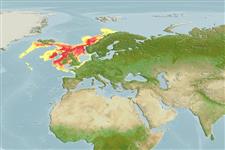Elasmobranchii (sharks and rays) >
Rajiformes (Skates and rays) >
Rajidae (Skates)
Etymology: Dipturus: Greek, di = two + Greek, pteryx = fin (Ref. 45335).
Environment: milieu / climate zone / depth range / distribution range
Ecology
Marine; demersal; depth range 1 - 1500 m (Ref. 114953), usually ? - 200 m (Ref. 114953). Temperate; 49°N - 70°N, 32°W - 15°E (Ref. 114953)
Northeast Atlantic: Iceland to the British isles, it was formerly more widespread, including the Mediterranean Sea and North Africa, but its range is thought to be reduced due to fishing.
Size / Weight / Age
Maturity: Lm ? range ? - ? cm
Max length : 285 cm TL male/unsexed; (Ref. 114424); max. published weight: 113.0 kg (Ref. 114424)
Short description
Identification keys | Morphology | Morphometrics
Anal spines: 0. This species is characterized by the following: snout long and pointed, length 3.7-5.1 times orbit length; disc broadly rhombic, anterior margin deeply concave; a row of 12-18 predorsal thorns in median row along tail (disc smooth in young); lateral thorns on tail pointed towards head; interspace between dorsal fins (2.4 ± 0.5 TL); upper surface dark olive-green in young with small pale spots, becoming greyish-brown; underside greyish or whitish; iris olive green (Ref. 114953, 127223).
A benthic species found in shelf and slope waters, mainly within the 200 m range but occasionally down to 1,500 m (Ref. 114953, 127218, 127220, 127222). Feeds on all kinds of bottom invertebrates and fish, including other skates (Ref. 114953). Oviparous, with long embryonic development. Males reach maturity at ca. 185 cm TL, females at 197 cm TL; birth size at ca. 29 cm TL, from large egg cases (up to 25 cm) (Ref. 114953). Biology unclear due to past taxonomic confusion.
Life cycle and mating behavior
Maturities | Reproduction | Spawnings | Egg(s) | Fecundities | Larvae
Last, P.R., S. Weigmann and L. Yang, 2016. Changes to the nomenclature of the skates (Chondrichthyes: Rajiformes). In: Last and Yearsley (eds.). Rays of the World: Supplementary Information. CSIRO Special Publication. 11-34. (Ref. 118749)
IUCN Red List Status (Ref. 130435)
Threat to humans
Harmless
Human uses
Tools
Special reports
Download XML
Internet sources
Estimates based on models
Phylogenetic diversity index (Ref.
82804): PD
50 = 0.5000 [Uniqueness, from 0.5 = low to 2.0 = high].
Bayesian length-weight: a=0.00282 (0.00133 - 0.00596), b=3.25 (3.08 - 3.42), in cm total length, based on LWR estimates for this Genus-body shape (Ref.
93245).
Trophic level (Ref.
69278): 4.1 ±0.6 se; based on size and trophs of closest relatives
Resilience (Ref.
120179): Very Low, minimum population doubling time more than 14 years (Preliminary K or Fecundity.).
Fishing Vulnerability (Ref.
59153): Very high vulnerability (90 of 100).
